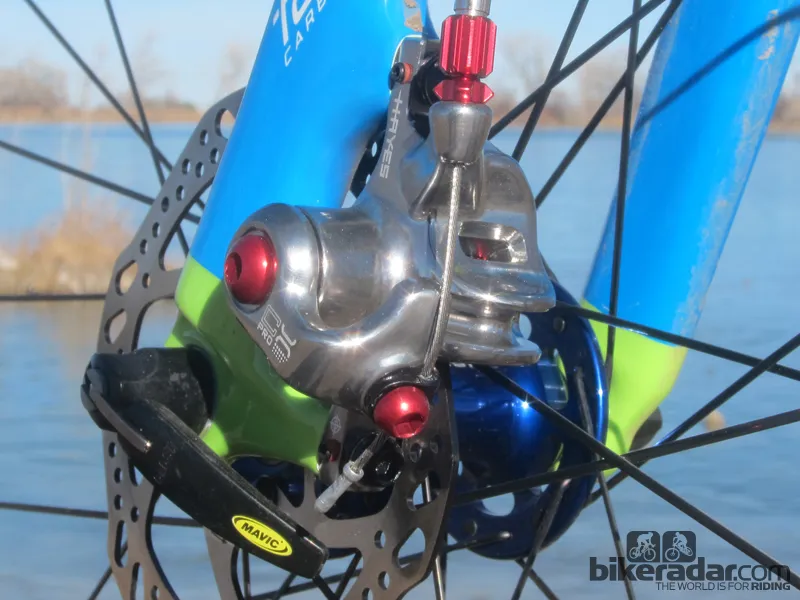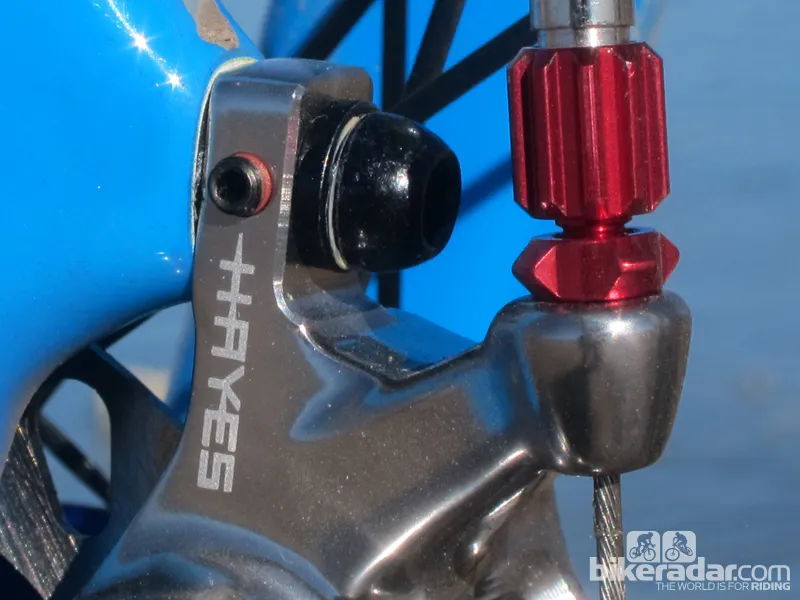Hayes makes a solid run at the high-end mechanical disc brake market with its latest CX Pro model. The CX Pro reasonably light, powerful in dry conditions, and easy on the eyes with its dark grey polished finish and red anodized aluminum hardware.
However, its performance degrades more than it should when it's wet or muddy and it's missing a couple of convenient adjustments.
- Highs: Excellent stopping power in dry conditions, great lever feel, very easy setup
- Lows: Disappointingly quick pad wear, flimsy aluminum cable anchor bolt, missing a couple of adjustments
Many of the CX Pro's most tangible benefits come directly from its sleek, one-piece aluminum caliper body. A tidy shape, extensive machining and a smattering of aluminum hardware keep the weight down to a competitive 161g per caliper with pads: 2g heavier than a TRP Spyre, 3g heavier than an Avid BB7 SL and 10g heavier than the Shimano BR-CX77.
Generously proportioned bridges connecting the two sides of the caliper give the caliper superb rigidity. Coupled with the torque arm's rather stiff (but non-adjustable) return spring and aggressive internal ramp geometry, this gives you a firm and very positive feeling lever plus highly predictable fingertip control with no discernible caliper flex.

Although the pads are unusually small with little surface area, braking power is actually outstanding thanks to the CX Pro's grippy semi-metallic pads. They also run impressively quietly with no undue squealing or grinding to speak of.
In dry conditions, this was one of our favorite mechanical disc brakes.
That all changed when conditions turn wet or muddy, though – just as they did during one of our races at the US Cyclocross National Championships on a highly technical course at Valmont Bike Park in Boulder, Colorado. We fully expect any disc brake performance to degrade somewhat in those environments but we were honestly quite surprised at just how big the difference was with the CX Pros.

Power fell off dramatically with little initial bite even after the rotors should have been scrubbed clean, and that once their quiet running stopped and they turned into a pair of howling banshees. To make matters worse, pad wear was very rapid, despite the fact that semi-metallic pads generally fare much better than organic ones in those environments. Our brakes were still functional after 45 minutes of racing but only just barely, with both levers nearly pulling to the bar before there was any effect.
Hayes admits that the CX Pro's semi-metallic compound does indeed wear about as fast as some competitors' organic pads. More durable sintered metallic pads will soon be available but even then, they're remarkably tiny with a surface area roughly half that of the BB7.
Unfortunately, the CX Pro's single-piston design also produces non-parallel and uneven pad wear, meaning we had to replace the pads completely in order to get things working properly. The pads are difficult to replace despite a clever magnetic retention system, because of the micro-sized tabs and bottom-fed layout – not exactly great traits for a brake aimed at the cyclocross crowd.
Initial setup is at least extremely quick though, thanks to a rather ingenious little feature that Hayes calls Crosshair. Two small set screws are situated perpendicular to the main caliper mounting bolts, pushing on them to provide ultra-fine positioning control that usually just isn't possible even for the most seasoned hands. Add in the adjustable inboard pad location, and it generally took us less than a couple of minutes to set up each end.

Even so, we still missed the ability to independently adjust the outboard pad of the likes of Avid and Shimano. Hayes instead relies on the CX Pro's built-in barrel adjuster to adjust the cable tension, which in turn alters the torque arm position to move the pad. Hayes says that an independent adjuster was consciously omitted in order to simplify the mechanism and reduce the size of the caliper. However, adjusting the outboard pad in this way still strikes us as a bit clumsy in comparison to the BB7 and BR-CX77, plus the CX Pro isn't any narrower than the Avid caliper anyway.
In addition, the non-indexed inboard pad adjustment allows for more precise pad adjustment but it won't reliably lock in place unless you snug down a separate set screw – not ideal for messy 'cross conditions where someone might have to make a quick adjustment before their rider comes through the pits again.
As pretty as it is, we also took issue with Hayes' decision to spec an aluminum cable anchor bolt. The torque spec is a reasonable 6Nm but even Hayes admits that its in-house testing shows that this critical bolt will fail at just 9Nm (and we measured 8Nm with a CDI Computorq digital torque wrench). Given the minute weight savings the alloy bolt offers plus the long-term effects of fatigue on aluminum hardware, we strongly recommend switching to a steel or high-quality titanium one instead. Hayes says it will replace any broken aluminum cable anchor bolts for free but it's a problem that we'd rather avoid entirely nonetheless.
The verdict: The Hayes CX Pro looks great and performs very well in dry conditions with excellent power, control, and lever feel. The Crosshairs alignment system is utterly brilliant too. Wet conditions have more of a negative effect on braking performance than we'd like though, and little details such as the finicky-to-replace pads, the flimsy aluminum cable anchor bolt, and semi-adjustable outboard pad position keep the CX Pro from being a top pick.
